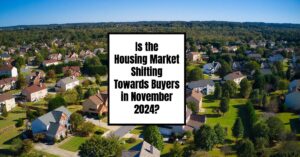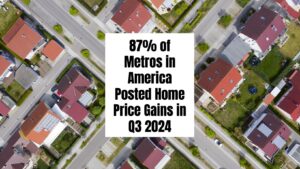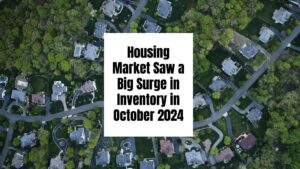What's going to happen in the real estate market in 2025? It's kinda tricky to say for sure. Things are pretty up and down right now, and nobody really knows what's going to happen next. The real estate market predictions for 2025 paint a picture of cautious optimism amidst a backdrop of volatility and uncertainty.
But, if we look at what's happening with the economy and what people are thinking, we can get a general idea. Experts are pretty cautiously optimistic – they think things might be okay, but there's a lot that could change. The market's always changing, so knowing what might happen is key.
While the market might not experience explosive growth, we can expect a more balanced environment with opportunities for both buyers and sellers. Let's dive deeper into these predictions and explore what factors will likely shape the market in 2025.
Real Estate Market Predictions 2025: Will Home Prices Rise or Fall?
📈
Key Takeaways
- 🏠 Modest Price Increase: Home prices are predicted to rise moderately, with experts forecasting increases ranging from 0.5% to 4.4%.
- 📝 Continued Inventory Challenges: The housing inventory is expected to remain constrained, affecting overall market activity.
- 🛠 Stabilization: After a tumultuous period, the market is anticipated to stabilize, offering opportunities for both buyers and sellers.
- 💰Mortgage Rates Influence: Interest rates will continue to play a significant role in shaping buyer behavior and housing affordability.
Understanding the Current Context
The past few years have been quite wild for the real estate market. The economy has been a big driver, with inflation, mortgage interest rates, and supply chain issues creating a lot of uncertainty. In 2023, higher mortgage rates made it tougher for people to buy homes, and many potential buyers were hesitant. As we move toward 2025, many analysts see a slight improvement in housing activity, but there will still be some hurdles.
According to U.S. News, while we might see a bit of a pickup in home sales, they are still expected to be lower compared to historical averages. This is because higher mortgage rates are still a concern, and many potential buyers are waiting to see how the economy settles before making such a big financial commitment.
Price Trends and Projections
Several reputable forecasts are suggesting a relatively small increase in home prices in 2025. For example, Goldman Sachs is predicting a 4.4% increase, while Freddie Mac has a more conservative outlook, estimating a 0.5% rise. Based on an analysis by ResiClub, the average prediction from various experts points to a 2.5% increase. This difference in opinions highlights how uncertain things are in the market.
| Forecast Source | Home Price Increase (%) |
|---|---|
| Goldman Sachs | 4.4 |
| Fannie Mae | 3.8 |
| Redfin | 4 |
| Freddie Mac | Slower Growth |
| Average Consensus | Moderation in Home Price Growth |
The reason for these varied predictions is likely due to differing views on the economy's recovery, buyer demand, and any unexpected events that might affect the entire country. For buyers and investors, it's essential to understand that these price increases may not be significant and avoid overly optimistic expectations.
In a report from the Q4 2024 Fannie Mae Home Price Expectations Survey (HPES), produced in partnership with Pulsenomics, LLC, a group of over 100 housing experts predicted home price growth to slow down from 5.2 percent in 2024 to 3.8 percent in 2025 and 3.6 percent in 2026. They see this slowdown stemming from higher mortgage rates and the recent rapid increase in home prices.
Mark Palim, Fannie Mae Senior Vice President and Chief Economist, noted that the experts believe that home price growth will slow down further in the coming years because the elevated mortgage rates and the faster home price growth seen over the past few years are making it hard for many people to afford homes.
Terry Loebs, founder of Pulsenomics, pointed out that even though most experts expect the home price appreciation rate to decrease from recent levels, they still expect the annual average price increase through 2029 to be higher than inflation, which indicates that affordability issues could persist.
In October 2024, the median sales price for a single-family home in the U.S. was $437,300, up from $426,800 the month before, according to U.S. Census data.
At the same time, the median rent price in the U.S. was $1,619 in October 2024, about the same or up 0.2% from a year ago and down 0.6% from the previous month, according to Redfin, an online real estate brokerage firm.
Redfin also provided predictions for the housing market in 2025:
- Home Price Growth Normalization: Home prices are projected to increase by about 4% throughout 2025, similar to the rate seen in the latter half of 2024. This represents a “normalization” after the rapid price growth of 2020.
- Rents to Stabilize or Decline: The median asking rent price in the U.S. is anticipated to remain flat or potentially decrease in 2025, as new rental units become available. This could provide more leverage for renters to negotiate with landlords.
- Increased Home Sales: Pent-up demand from buyers and sellers who have been waiting on the sidelines could lead to a rise in home sales in 2025, potentially increasing by 2% to 9% compared to 2024.
In addition to these national trends, local market conditions will continue to be influential. For example, some areas with a lot of new apartments, like Austin, Texas, saw rent prices go down, while others with limited supply, such as Seattle, Washington, D.C., and New York City, continued to see rent prices rise.
Inventory Dynamics and Buyer Demand
Inventory levels have been a major challenge in the housing market for a while, leading to a limited number of homes for sale. While some stabilization is expected, experts predict that housing inventory will stay below average levels through 2025. Bankrate highlights that if mortgage rates stay high, many homeowners might choose to stay put instead of moving, a phenomenon known as “rate lock.”
Buyers will encounter difficulty finding affordable housing as inventory remains tight. While new home construction might increase, it will take some time for the inventory to improve considerably.
The National Association of Realtors reports that even though there may be a few more new homes built, demand for housing is still outpacing the available supply. This imbalance might create competitive bidding situations in some popular areas, which could prevent prices from falling much, even in a slower market.
Economic Influences on the Housing Market
The overall health of the economy also plays a significant role in shaping the future of the real estate market in 2025. Inflation remains a concern for many American households, impacting consumer confidence and spending habits. If inflation continues, central banks might change interest rates, which can either slow down or further stimulate the housing market. Bankrate suggests that if inflation stabilizes and interest rates decrease, we might see more buyer activity, which could change how the market is behaving.
Job growth is also incredibly important. As more jobs are created, household incomes increase, leading to higher buying power. However, any signs of an economic downturn could reverse these gains, causing potential buyers to take a “wait-and-see” approach.
Consumer Sentiment and Behavior
How consumers feel about buying homes will significantly influence the real estate market predictions for 2025. People have to weigh the comfort level of spending on a big purchase against their financial responsibilities and the broader economic situation. Based on conversations with real estate professionals, it seems that buyers are being more cautious and doing thorough research before making a significant investment. This careful approach could further slow down sales.
For example, Tammie Carter, a licensed Realtor, as quoted in Yahoo Finance, stated, “The real estate market in 2025 is expected to experience a period of stabilization and modest growth.” This cautious sentiment is echoed throughout the industry, with real estate agents and analysts recognizing the need for buyers to feel financially secure before entering the market.
Regional Insights and Variations
While national trends provide a general idea of the market, local markets can have very different characteristics. For instance, areas that saw rapid home price growth might experience a leveling off or a small decrease as affordability becomes a challenge. On the other hand, regions with slower growth might finally see an increase in activity as buyers seek more affordable options.
According to a Forbes report, cities in the Midwest and South could exhibit more resilience and potentially attract new residents due to lower costs of living and expanding job markets. In contrast, major metropolitan areas like San Francisco and New York might face unique challenges as technology job cuts continue and living expenses remain high.
Technological Influence on the Real Estate Market
As we approach 2025, technology will play a more prominent role in shaping the real estate market. The rise of virtual home tours, online closings, and AI-powered market analysis tools has changed how people search for and buy properties. This digital shift enables buyers to efficiently browse listings and make informed decisions.
Furthermore, data analytics can help real estate professionals make more accurate market predictions. New platforms that compile real-time data provide insights that were previously unavailable, enabling agents to develop better strategies and cater to client needs more effectively.
Partner with Norada, Your Trusted Source for Turnkey Investment Properties
Discover high-quality, ready-to-rent properties designed to deliver consistent returns. Contact us today to expand your real estate portfolio with confidence.
Reach out to our investment counselors:
(949) 218-6668 | (800) 611-3060
Conclusion
While predicting the future of the real estate market with absolute certainty is challenging, the real estate market predictions for 2025 suggest a more stable environment compared to the recent period of volatility. The market is expected to stabilize, with modest home price increases and a gradual recovery in home sales. The influence of mortgage rates, economic conditions, and consumer sentiment will be crucial factors in shaping the market.
As a homeowner, buyer, or seller, it's essential to be informed about these trends and work with a trusted real estate professional to navigate the market effectively. Understanding these predictions and the potential challenges and opportunities allows you to make informed decisions that align with your financial goals and circumstances.
Remember that the real estate market is dynamic and can change quickly. Keeping up-to-date with current conditions and local market trends is vital for making smart decisions about your property investments.
Recommended Read:
- Housing Market Forecast for the Next 2 Years: 2024-2026
- Housing Market Predictions for the Next 4 Years: 2025 to 2028
- Real Estate Forecast Next 5 Years: Top 5 Predictions for Future
- Is the Housing Market on the Brink in 2024: Crash or Boom?
- 2008 Forecaster Warns: Housing Market 2024 Needs This to Survive
- Housing Market Predictions for the Next 2 Years
- Real Estate Forecast Next 10 Years: Will Prices Skyrocket?
- Housing Market Predictions for Next 5 Years (2024-2028)
- Housing Market Predictions: 8 of Next 10 Years Poised for Gains
- Trump vs Harris: Which Candidate Holds the Key to the Housing Market (Prediction)











